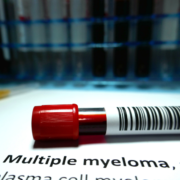What Are Currently Available Myeloma Treatments?
What Are Currently Available Myeloma Treatments? from Patient Empowerment Network on Vimeo.
Dr. Omar Nadeem reviews myeloma treatment classes, including immunomodulatory therapies, proteasome inhibitors, and monoclonal antibodies. Dr. Nadeem also discusses how combining these therapies has boosted the effectiveness of myeloma treatment.
Dr. Omar Nadeem is the Clinical Director of the Myeloma Immune Effector Cell Therapy Program and Associate Director of the Multiple Myeloma Clinical Research Program at the Dana-Farber Cancer Institute. Learn more about Dr. Nadeem.
Related Programs:

Which Myeloma Patients Are Candidates for CAR-T Cell Therapy? |

|

|
Transcript:
Katherine Banwell:
Dr. Nadeem, what types of myeloma treatment classes are currently available?
Dr. Omar Nadeem:
Yes. So, we started over three decades ago plus with just having basically steroid medications and some older chemotherapy drugs that weren’t very targeted at all, and that was basically all we had up until about a little over 20 years ago, where immunomodulatory drugs were first discovered to be effective in multiple myeloma, and that included thalidomide (Contergan or Thalomid) and now a commonly used agent called lenalidomide, or Revlimid.
After that, we had a next class of medications approved called proteasome inhibitors that work differently than the immunomodulatory drugs, and then we combined all of these therapies about a decade plus ago and showed that that was better than anything else that we were doing before that. So, combining the steroids with the immunomodulatory drugs and proteasome inhibitors became the standard of care.
And then we had the next class of drugs approved in 2015 called monoclonal antibodies, and that’s the first time we have monoclonal antibodies approved for myeloma, and it first started in patients that had relapsed myeloma, and then they made it all the way up to front line therapy with a drug in particular called daratumumab (Darzalex).
And now what we’re going is entering an era of combining all four of these therapies, just like we did 10 years ago with three drugs, and showing that combining four drugs is actually better than three. And the important thing there is that it’s not necessarily adding cumulative toxicity. These are targeted therapies; they all work differently, but they all work really well together. So, now combining these agents has allowed us to really treat the disease effectively and allow for patients to tolerate the therapies.
And then over the last couple of years, we’ve now entered kind of the next renaissance in myeloma where you have immunotherapies, and these are sort of true immunotherapies, in some cases taking the patient’s own T cells and then genetically modifying them to recognize myeloma cells and putting them back into patients. This is called CAR T-cell therapy, and that’s now approved for patients with multiple myeloma.
And that again, just like the previous drug, sits in patients that have – you know, at a space where patients have had multiple relapses. But we’re now studying that earlier and earlier, and that along with another class of drugs called bispecific antibodies that also use your T cells via a different mechanism. A lot of exciting things going on, and we keep adding to the available agents for this disease.










